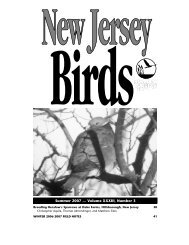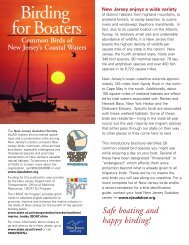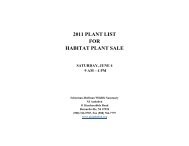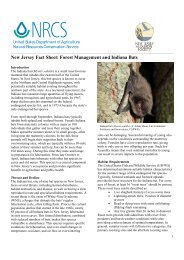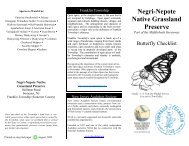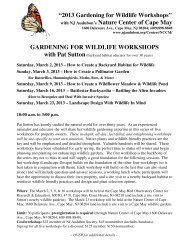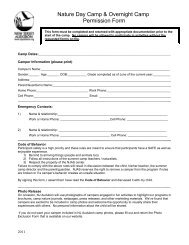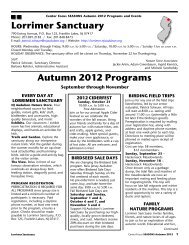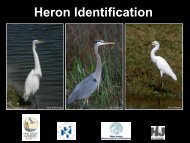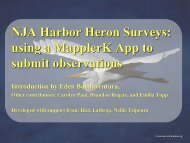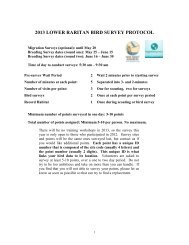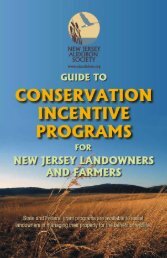2008 grassland bird survey protocol - New Jersey Audubon Society
2008 grassland bird survey protocol - New Jersey Audubon Society
2008 grassland bird survey protocol - New Jersey Audubon Society
You also want an ePaper? Increase the reach of your titles
YUMPU automatically turns print PDFs into web optimized ePapers that Google loves.
<strong>New</strong> <strong>Jersey</strong> <strong>Audubon</strong> <strong>Society</strong><br />
Citizen Science Program<br />
<strong>2008</strong> Grasslands Bird Monitoring Survey Protocol<br />
<strong>2008</strong> GRASSLAND BIRD SURVEY PROTOCOL<br />
Volunteer Commitment Dates: April 12, <strong>2008</strong> – July 31, <strong>2008</strong><br />
Time of day to conduct <strong>survey</strong>s: 5:30 am – 9:30 am<br />
Pre-<strong>survey</strong> Wait Period<br />
Number of minutes at each point:<br />
Number of visits per point:<br />
Bird <strong>survey</strong>s<br />
Data Entry<br />
Wait 2 minutes prior to starting <strong>survey</strong><br />
5 minutes: separated into 3- and 2-minutes<br />
Two (<strong>bird</strong> <strong>survey</strong>s only, no habitat<br />
<strong>survey</strong>s in <strong>2008</strong>)<br />
One from May 15-31 and one from<br />
June 1-15<br />
Entered electronically and mailed to NJAS<br />
by July 31, <strong>2008</strong><br />
Minimum number of points <strong>survey</strong>ed in one day: 1 Route/Site<br />
Protocol for volunteers<br />
All citizen scientists are required to attend a training workshop. During this workshop,<br />
routes and/or sites will be assigned and corresponding maps will be handed out. Each<br />
volunteer will be required to do at least one route/site. We will make every attempt to match<br />
volunteers to their preferred counties. Volunteers are welcome to <strong>survey</strong> multiple routes; but<br />
do not try to be too ambitious and take on more than you can handle. It will be much more<br />
difficult to reassign routes after the <strong>survey</strong>s have been initiated, and they all need to be<br />
completed this year.<br />
Reporting Time<br />
All volunteer hours spent performing <strong>grassland</strong>s <strong>bird</strong> <strong>survey</strong>s must be recorded on the<br />
provided timesheet. The project name is <strong>2008</strong> Grasslands Bird Surveys. In addition to the<br />
project name please record the Site Code, especially if you are working on more than one<br />
route/site. Make sure that all information is filled in every time you go into the field to work on<br />
this project. This includes scouting, <strong>bird</strong> <strong>survey</strong>s, data entry, etc. Also be sure to record the<br />
miles traveled during each <strong>survey</strong>. NJAS must provide this timesheet to our partners at the<br />
Division of Fish and Wildlife. It is essential that this form be completed and returned to NJAS<br />
with your data sheets at the end of the field season.<br />
Scouting<br />
Prior to the first <strong>bird</strong> <strong>survey</strong>, every point in each route/site needs to be scouted to<br />
determine suitability and accessibility. This initial visit must take place from April 12 – May 14.<br />
If a point is inaccessible or unsuitable, the point may be moved to suitable habitat at a nearby<br />
location. To move a point, choose a location with suitable habitat on your route map that is at<br />
Page 1 of 7
<strong>New</strong> <strong>Jersey</strong> <strong>Audubon</strong> <strong>Society</strong><br />
Citizen Science Program<br />
<strong>2008</strong> Grasslands Bird Monitoring Survey Protocol<br />
least 0.5 mile (straight distance) from any other point. Suitable habitat is an open area (no trees<br />
or shrubs), greater than 5 hectares (12.5 acres) and dominated by grasses and forbs. When you<br />
find the new point location, draw an arrow on the route map from the old point location to the<br />
new one and indicate why it was moved (developed, inaccessible, etc). If there are no other<br />
suitable locations that meet the criteria to move a point, then mark it on the map with an X and<br />
indicate why it was not <strong>survey</strong>ed (developed, inaccessible, etc.). PLEASE LET US KNOW<br />
(kristin.mylecraine@njaudubon.org) about any points that you move. If the area around the<br />
original point is not a <strong>grassland</strong> habitat anymore, for example, it has been developed, please let<br />
us know immediately.<br />
Bird Surveys<br />
Make sure you are familiar with the songs of species likely to be seen during your<br />
<strong>survey</strong>s, and the points on identification. Some species are rather secretive and do not allow<br />
close approach for visual identification. We have provided CDs of songs to all participants in<br />
the training workshops, and you are encouraged to keep practicing. We recommend you use a<br />
good field guide for visual identification.<br />
Each volunteer will be responsible for one or more routes and/or sites. A route<br />
follows existing roads through <strong>grassland</strong> habitat and consists of <strong>survey</strong> points. Each point is<br />
located at a pre-determined location from which the observer conducts the <strong>bird</strong> <strong>survey</strong>. The<br />
radius around each point for 100 meters is considered the “map-circle”. An interior circle<br />
with a 25 meter radius is also part of the map-circle. Routes vary in length and have different<br />
numbers of points.<br />
A site is a property that contains <strong>grassland</strong> habitat, which is being managed for<br />
<strong>grassland</strong> <strong>bird</strong> species. Observers are granted permission by the landowner (through their<br />
contract with the State) to enter the property to <strong>survey</strong>. Site sizes vary, but most contain 1-5<br />
<strong>survey</strong> points with the same count circle method employed.<br />
**Note on Routes: those of you who have been assigned a roadside route must<br />
run the first <strong>bird</strong> <strong>survey</strong> in numerical order by point from the lowest number to<br />
the highest number. The second run is done in reverse going from the highest<br />
point number to the lowest. This is done so that points aren’t <strong>survey</strong>ed at the<br />
same time of day during each <strong>survey</strong> period.<br />
Surveys should not be conducted during rain or during periods of high winds (greater<br />
than 12mph {Beaufort 3}, which is enough to constantly move leaves or twigs and to extend a<br />
light flag). Every point in a route must be <strong>survey</strong>ed on the same day. Surveys will take place<br />
from one half hour before to four hours after sunrise (approximately between 5:30 AM and<br />
9:30 AM), two times during the breeding season, preferably from May 15-31, and June 1-15.<br />
Surveys must take place at least 7 days apart. For example, do not conduct one of your <strong>survey</strong>s<br />
on May 31 st and the other one on June 4.<br />
Once the observer arrives at the <strong>survey</strong> point wait 2 minutes before beginning the count.<br />
This enables the observer to prepare for the count and allows the <strong>bird</strong>s to calm down and return<br />
to normal activity. During the <strong>survey</strong> the observer stands at the point for 5 minutes and records<br />
on the data sheet all <strong>grassland</strong> <strong>bird</strong> species seen or heard. This 5-minute period is divided into<br />
Page 2 of 7
<strong>New</strong> <strong>Jersey</strong> <strong>Audubon</strong> <strong>Society</strong><br />
Citizen Science Program<br />
<strong>2008</strong> Grasslands Bird Monitoring Survey Protocol<br />
two periods; a 3- and a 2-minute period. The observer records the species and number of <strong>bird</strong>s<br />
seen or heard during the first 3 minutes separately from those encountered during the next 2<br />
minutes. Record all <strong>bird</strong>s as less than 25 meters, 25-100 meters or greater than 100 meters away<br />
from the <strong>survey</strong> point on the data sheet. Plot all individuals of target species observed at less<br />
than 100 meters on the circle map with the abbreviation of the common name (see Appendix III).<br />
Do not count longer than five minutes. Do not exceed the 5-minute time limit because you are<br />
sure a certain "good <strong>bird</strong>" is there and not calling -- it will probably be recorded some other year,<br />
and valid negative data are as important as positive data in this <strong>survey</strong>. Species recorded that are<br />
not found on the form should be added at the bottom. If you observe a target species before or<br />
after the 5-minute <strong>survey</strong>, write it down in the margin or blank spaces on the bottom of the<br />
datasheet with a “before” or “after” next to it.<br />
One and only one observer should conduct the count. Counting should be done from<br />
outside the car from a stationary point. Absolutely no method of coaxing <strong>bird</strong>s should be used<br />
during the 5-minute <strong>survey</strong> period. This means no "spishing", tape playbacks or any other<br />
method of enticing a <strong>bird</strong> to sing or call or make itself visible. It is crucial that all <strong>survey</strong>s be<br />
done consistently. Target <strong>bird</strong>s observed between stops should not be counted, but may be noted<br />
in the margin of the route map with a line indicating the location of the species. Such <strong>bird</strong>s are of<br />
interest, but do not spend extra time pursuing them, as it is important to finish within the time<br />
limit; <strong>bird</strong> activity changes drastically after this time.<br />
Be sure you record the <strong>survey</strong> site code, <strong>survey</strong> point number, observer,<br />
recorder (if applicable), date, start time and weather conditions on every datasheet.<br />
Each <strong>survey</strong> will be undertaken singly or by two people. We prefer single observers<br />
because we do not want the volunteer’s ability to concentrate on the <strong>bird</strong>s to be compromised by<br />
the presence of another person. However, if you want to conduct the <strong>survey</strong>s with your <strong>bird</strong>ing<br />
partner, please take all precautions to avoid being distracted. Remember, only one person should<br />
be the primary observer. The second person can act as the recorder in this situation. If there are<br />
two observers, the primary observer says what she/he sees or hears to the recorder in a quiet<br />
voice and the recorder repeats back what she/he heard as the data is recorded. Only the <strong>bird</strong>s<br />
seen and heard by the primary observer get recorded on the forms. If the recorder sees or hears<br />
a target species before or after the 5-minute <strong>survey</strong>, write it down in the margin or blank<br />
spaces on the bottom of the datasheet with a statement that this is a recorder observation.<br />
**Note on Counting the Same Bird: The same <strong>bird</strong> seen/heard in the 3-minute<br />
portion of the <strong>survey</strong>, then seen/heard again in the 2-minute portion is ONLY<br />
recorded in the 3-minute period as this is definitely a single individual. If you<br />
are sure that a <strong>bird</strong> observed in the 2-minute period is different from the one<br />
observed in the 3-minute period, by all means record it as a different individual<br />
in the 2-minute time slot. Noting on the data sheet that you were sure two<br />
different <strong>bird</strong>s were observed will help with our data entry.<br />
In all situations, avoid biasing the data by disturbing the <strong>bird</strong>s. Walk out of your car<br />
quietly, approach the <strong>survey</strong> point cautiously, avoid unnecessary movements and try to blend in<br />
as much as possible.<br />
Page 3 of 7
<strong>New</strong> <strong>Jersey</strong> <strong>Audubon</strong> <strong>Society</strong><br />
Citizen Science Program<br />
<strong>2008</strong> Grasslands Bird Monitoring Survey Protocol<br />
Data Entry<br />
All observers will have access to NJAS’s online data entry website. Go to<br />
http://www.njaudubon.org/Research/CitizenScience/Grassland_Surveys.html. At the bottom of<br />
the page you can click on Enter Data. This will send you to a new page. Click on the link:<br />
http://www.njaudubon.org/GrasslandWeb At the bottom of the page click Create a <strong>New</strong><br />
Account. Enter a User ID for yourself. Enter a password (at least 5 characters) and confirm that<br />
password. Enter your name, phone number and email address in the appropriate box. In the Site<br />
Password box type <strong>grassland</strong>. A page will open that asks you for the new User ID and<br />
password. Type them in, hit enter and you should be relocated to the data entry page. If you<br />
have any technical difficulties with this please let me know immediately so we can correct the<br />
problem. Once you have entered all of your data please mail all data sheets by August 31, <strong>2008</strong><br />
to:<br />
Kristin Mylecraine<br />
<strong>New</strong> <strong>Jersey</strong> <strong>Audubon</strong> <strong>Society</strong><br />
Scherman-Hoffman Wildlife Sanctuary<br />
11 Hardscrabble Road<br />
Bernardsville, NJ 07924<br />
Thank you for your assistance and good luck with all of your <strong>survey</strong>s.<br />
Page 4 of 7
<strong>New</strong> <strong>Jersey</strong> <strong>Audubon</strong> <strong>Society</strong><br />
Citizen Science Program<br />
<strong>2008</strong> Grasslands Bird Monitoring Survey Protocol<br />
Appendix I. WEATHER CONDITIONS (FROM BREEDING BIRD SURVEY)<br />
WIND SPEED CODES:<br />
Beaufort<br />
Scale<br />
Wind Speed<br />
in mph<br />
Indicators of Wind Speed<br />
0 Less than 1 Smoke rises vertically<br />
1 1 to 3 Wind direction shown by smoke drift<br />
2 4 to 7 Wind felt on face; leaves rustle<br />
3 8 to 12 Leaves, small twigs in constant motion; light flag extended<br />
4 13 to 18 Raises dust and loose paper; small branches are moved<br />
5 9 to 24 Small trees in leaf sway; crested wavelets on inland waters<br />
SKY CONDITION CODES:<br />
0 Clear or a few clouds<br />
1 Partly cloudy (scattered) or variable sky<br />
2 Cloudy (broken) or overcast<br />
4 Fog or smoke<br />
5 Drizzle<br />
7 Snow<br />
8 Showers<br />
NOTE: Surveys should not be conducted when wind speeds exceed Beaufort 3, and/or<br />
during sky conditions 5-8 (drizzle, snow, rain showers).<br />
Page 5 of 7
<strong>New</strong> <strong>Jersey</strong> <strong>Audubon</strong> <strong>Society</strong><br />
Citizen Science Program<br />
<strong>2008</strong> Grasslands Bird Monitoring Survey Protocol<br />
Appendix II: Equipment Checklist<br />
Clipboard & Pencils, Erasers, etc.<br />
Bird Count Datasheets for all <strong>survey</strong> points<br />
Overall Site Maps on aerial photo<br />
Survey Point Maps with Count Circle on aerial photo (one for each point)<br />
Route Map(s)<br />
Binoculars<br />
Watch with second hand (or timer)<br />
Compass (optional)<br />
GPS Unit (optional)<br />
Thermometer (optional)<br />
Page 6 of 7
<strong>New</strong> <strong>Jersey</strong> <strong>Audubon</strong> <strong>Society</strong><br />
Citizen Science Program<br />
<strong>2008</strong> Grasslands Bird Monitoring Survey Protocol<br />
Appendix III: Target Species and Abbreviations<br />
Target Grassland Species<br />
American Kestrel<br />
AMKE<br />
Bobolink<br />
BOBO<br />
Dickcissel<br />
DICK<br />
Eastern Meadowlark<br />
EAME<br />
Grasshopper Sparrow GRSP<br />
Henslow’s Sparrow<br />
HESP<br />
Horned Lark<br />
HOLA<br />
Northern Bobwhite<br />
NOBO<br />
Northern Harrier<br />
NOHA<br />
Savannah Sparrow<br />
SAVS<br />
Sedge Wren<br />
SEWR<br />
Upland Sandpiper<br />
UPSA<br />
Vesper Sparrow<br />
VESP<br />
Scrub-Shrub Dependent Species<br />
Black-billed Cuckoo<br />
BBCU<br />
Blue Grosbeak<br />
BLGR<br />
Blue-winged Warbler BWWA<br />
Brown Thrasher<br />
BRTH<br />
Chestnut-sided Warbler CSWA<br />
Eastern Blue<strong>bird</strong><br />
EABL<br />
Eastern Towhee<br />
EATO<br />
Field Sparrow<br />
FISP<br />
Golden-winged Warbler GWWA<br />
Indigo Bunting<br />
INBU<br />
Prairie Warbler<br />
PRAW<br />
Red-winged Black<strong>bird</strong> RWBL<br />
White-eyed Vireo<br />
WEVI<br />
Yellow-billed Cuckoo YBCU<br />
Yellow-breasted Chat YBCH<br />
You will undoubtedly observe many other species. Though data regarding these<br />
species are interesting to NJAS, the main focus of the project is to record the<br />
required information pertaining to the target <strong>grassland</strong> species. We recommend not<br />
spending considerable time focusing in on the more common species (i.e. Song<br />
Sparrow), but feel free to note them on the datasheet.<br />
Page 7 of 7



